The Evolution of British Bathrooms: A Historical Journey
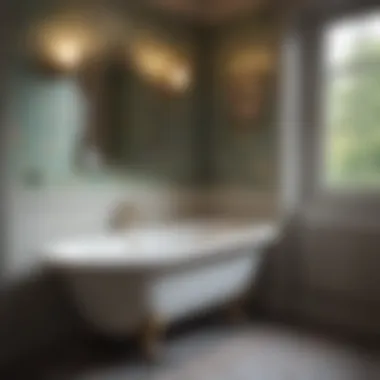
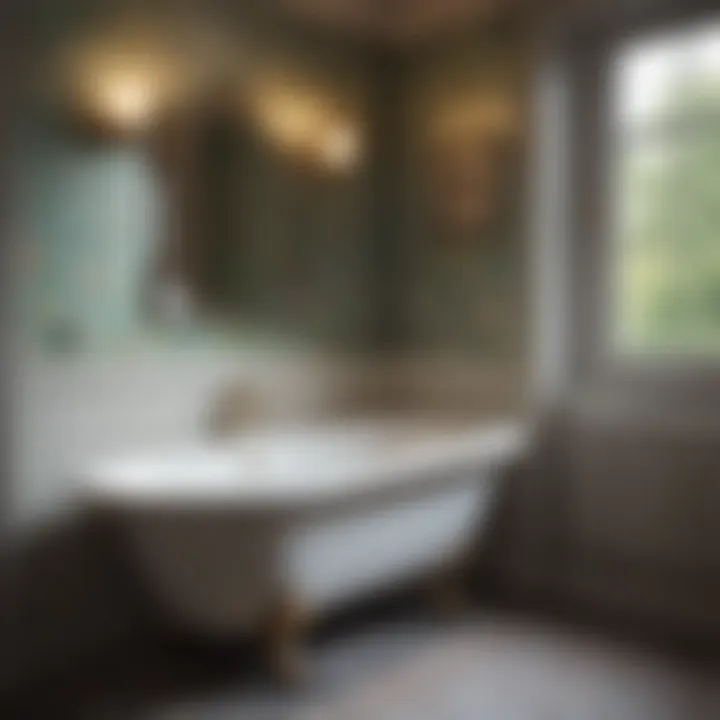
Intro
The bathroom is more than just a functional space; it is a reflection of personal style and a testament to changing societal norms. In Britain, the evolution of bathrooms encapsulates a journey through time, revealing shifts in both design and purpose. Historically, the bathroom has undergone significant transformations that mirror advancements in technology, hygiene practices, and cultural expectations.
This article ventures into the core components that have defined British bathrooms over the decades. By exploring architectural styles, practical considerations, and societal influences, we aim to paint a comprehensive picture of this essential space in homes across Britain. Homeowners, designers, and enthusiasts will find insightful perspectives on how functionality and aesthetics coexist in bathrooms today.
Design Inspiration
In the realm of interior design, the British bathroom landscape has been continually shaped by various influences.
Current Trends in Interior Design
The modern British bathroom exhibits an array of design trends that prioritize comfort alongside functionality. Minimalist design has become popular, featuring clean lines and uncluttered spaces. This approach emphasizes the importance of maximizing space without overwhelming the senses. Earthy tones and natural materials, including wood and stone finishes, are in vogue as they evoke a sense of tranquility.
The adoption of smart technology also marks a key trend in modern bathrooms. From smart mirrors that display information to digitally controlled shower systems, technology plays an increasingly integral role. These innovations enhance user experience, making daily routines more convenient and efficient. Integrated audio systems for playing soothing music or news podcasts while one prepares for the day is becoming common.
Color Schemes and Palette Ideas
When considering color palettes for British bathrooms, neutral shades often take precedence. Whites, grays, and soft pastels create a calming atmosphere that can make the space feel both larger and more inviting. Additionally, the introduction of bold accent colors can inject personality into the design. For example:
- Deep navy blue for cabinetry
- Rich forest green for wall tiles
- Warm terracotta for accessories
Utilizing contrasting colors can create visual interest. Therefore, experimenting with various tones can help homeowners craft a space that feels uniquely theirs, while still remaining functional.
"A well-designed bathroom can inspire a sense of peace and rejuvenation, important for everyday living."
By merging classic elements with contemporary trends, British bathrooms can achieve a sophisticated look that resonates with modern sensibilities, whilst respecting historical influences.
In subsequent sections, we will further delve into the historical context of British bathrooms, their societal implications, and the enduring impact of design choices on today’s bathrooms.
Historical Context of British Bathrooms
The historical context of bathrooms in Britain provides essential insight into how this private space has developed and transformed. Understanding the evolution highlights trends, societal shifts, and design influences that contribute to what we see today. The bathroom is not merely a functional area but a reflection of changing attitudes towards hygiene and comfort.
In earlier times, bathing practices varied significantly across social classes and regions. The designs of bathrooms speak volumes about cultural priorities and technological advancements. As society evolved, so did the expectations surrounding cleanliness and the need for a designated space for personal care. This historical examination reveals the intricate relationship between health, comfort, and aesthetics in British homes.
Early Sanctuaries: The Origins of Bathing in Britain
The origins of bathing in Britain trace back to ancient practices. Early bathing places were often communal and tied closely to social customs. The Romans introduced the concept of baths with their baths systems across Britain, which emphasized not just hygiene, but also social interaction. These early sanctuaries encouraged a routine that blended leisure and cleanliness, establishing bathing as a social activity.
These public baths were often elaborately designed and became centers of community life. However, with the decline of Roman influence, private bathing became rare. It was often considered a luxury. The prevalence of cold-water bathing persisted for centuries, influenced by various factors, including climate and social beliefs.
The Victorian Era: Revolutionizing Bathroom Design
The Victorian era marked a significant turning point in bathroom design and societal attitudes towards bathing. This period emphasized health and hygiene, coinciding with advances in plumbing and sanitation. Bathrooms evolved from simple water closets to more sophisticated spaces equipped with bathtubs, sinks, and elaborate fixtures.
Victorians began to see the bathroom as a sanctuary for personal welfare. Intricate tiles, ornate mirrors, and artful woodwork became standard features in wealthy households. The inclusion of features like hot and cold running water transformed the bathing experience.
This era set the foundation for modern bathroom design, combining functionality with aesthetics, which continues to influence trends today.
The Post-War Influence on Bathroom Styles
After World War II, the need for efficient housing drove a wave of design innovations. Bathrooms became more functional, with an emphasis on practicality for growing families. Smaller spaces designed for efficiency emerged. This necessity led to the widespread adoption of fixtures that maximized the use of space, such as shower units and compact storage solutions.
The post-war period also reflected broader societal changes, as public health campaigns promoted hygiene. This era witnessed increased affordability of materials and a growing market for prefab bathroom units. The shift toward a more utilitarian approach changed the aesthetic, with softer, pastel colors replacing the ornate palettes of the Victorian era.
In summary, the historical context of British bathrooms highlights a multifaceted journey. From early communal bathing to the complexities of Victorian styles and later post-war efficiency, the bathroom reflects broader societal transitions and technological progress that shaped its evolution over time.
Architectural Characteristics of Bathrooms
The architectural characteristics of bathrooms provide an essential framework for understanding the evolution of this space. Bathrooms in Britain reflect not only personal preferences but also broader societal trends and architectural movements. Their layout, design, and finishes are critical in ensuring functionality and aesthetic appeal. Emphasizing the architectural characteristics allows us to appreciate how these spaces have transformed over time, catering to changing lifestyles and technological advancements.
Traditional British Bathroom Layouts
Traditional British bathroom layouts have typically emphasized a clear separation between the lavatory and the bathing area. This segmentation reflects a historical perspective on hygiene and privacy. Oftentimes, the design was influenced mainly by practicality rather than stylistic concerns.
Many homes featured a basic arrangement with a bathtub or a washbasin positioned against a wall. Fixtures like the sink and toilet were usually placed in close proximity, making effective use of limited space. The use of natural light was often prioritized, with tall windows or skylights allowing sunlight to brighten the area.
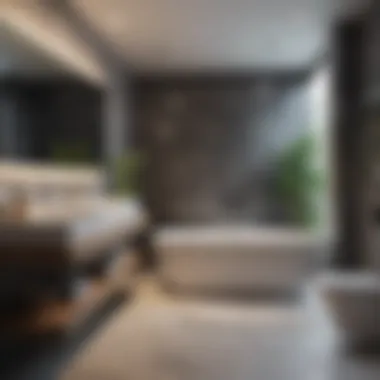
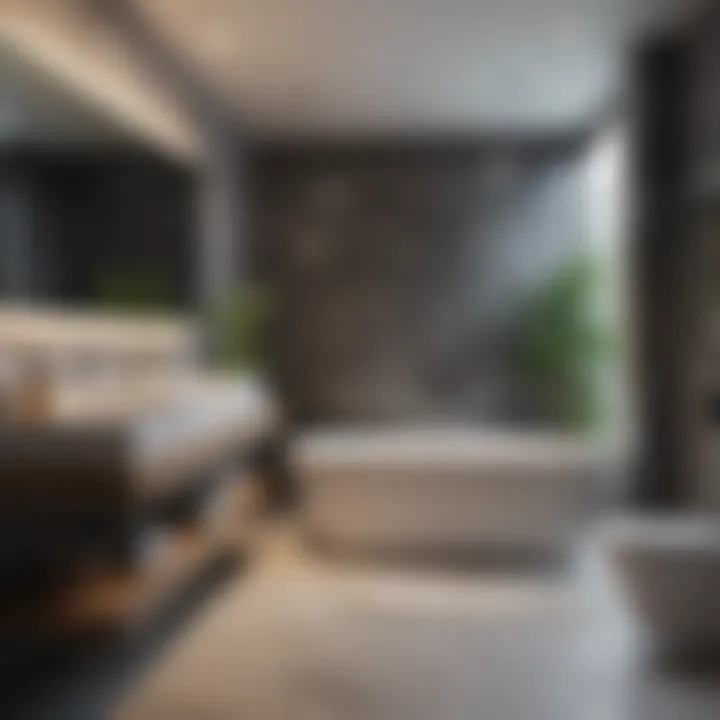
In the earlier periods, bathrooms were sometimes positioned away from the main living areas, serving more as a service space. The focus remained, primarily, on functionality, with minimal embellishment. However, in the mid-20th century, layouts started to evolve, incorporating thoughtful design elements that balanced convenience with comfort.
Contemporary Designs: Merging Form with Function
Contemporary bathroom design in Britain champions the melding of form and function. This approach acknowledges that a bathroom should not only serve practical needs but also offer a calming retreat. Accessibility and space optimization are pivotal in today’s designs.
Open plan layouts have become increasingly popular, allowing for seamless interaction between the bathing area and other living spaces. Features such as freestanding bathtubs and wall-mounted toilets are common, maximizing floor space.
Moreover, innovative storage solutions are integrated into contemporary designs, like recessed shelves and cabinets, which help maintain a clean aesthetic while ensuring that necessary items are easily retrievable. The choice of materials also plays a significant role in enhancing both the look and functionality of bathrooms. For instance, the use of sustainable materials is becoming a key trend, yielding both environmental benefits and modern appeal.
"The integration of technology facilitates efficiency in modern bathroom designs, enhancing user experience while complementing the overall aesthetic."
In sum, the architectural characteristics of bathrooms distinctly reflect the evolution of societal needs. They narrate a story of adaptability and responsiveness to changing circumstances, revealing how these intimate spaces continue to be reimagined in British homes.
Materials and Finishes in British Bathrooms
The materials and finishes chosen for British bathrooms play a decisive role in shaping both the aesthetic appeal and functional effectiveness of the space. These elements contribute not only to the overall look of the bathroom but also to its longevity, maintenance needs, and comfort. A well-thought-out selection can elevate a simple bathroom into a luxurious sanctuary, while careless choices can lead to a space that feels out of touch or, worse, deteriorates rapidly over time. In this section, we will analyze the materials historically favored in British bathrooms and those that represent modern advancements in design.
Classic Materials: Porcelain and Marble
Historically, porcelain and marble have been flagship materials in British bathroom design. Porcelain is renowned for its durability and low maintenance requirements. It is often seen in tiles, sinks, and bathtubs. Its non-porous surface resists staining and is easy to clean, making it an enduring choice for homeowners.
Marble, with its elegant veining and luxurious appeal, has also been a popular option, especially in more upscale homes. Its beauty adds a sense of opulence. However, it does come with drawbacks. Marble is porous, so it can absorb stains if not sealed properly. Proper care is often necessary to maintain its appearance.
In summary, both porcelain and marble create timeless elegance. Their durability ensures they remain in the bathrooms of discerning homeowners despite changes in trends.
Innovative Materials in Modern Design
As we progress into contemporary bathroom design, new materials are emerging that not only enhance appearance but also address sustainability and functionality. For example, engineered stone offers a resilient alternative to natural stone, combining quartz with resins for added strength. It is a non-porous material, which prevents staining and simplifies cleaning.
Another innovative material is recycled glass. Frequently used in tiles or sinks, it boasts a range of colors and finishes and is ecologically friendly. The adoption of such materials reflects a growing awareness within the industry regarding environmental impacts.
In addition to sustainability, composite materials are gaining traction. They provide flexibility in design and often integrate features like antimicrobial properties, making them practical for modern bathrooms.
Functionality: The Practicalities of British Bathrooms
The practical aspects of bathroom design play a critical role in ensuring that these spaces not only serve their primary functions but also enhance the overall experience of usage. In a country like Britain, where homes vary significantly in size and structure, functionality must address both space limitations and user needs. This section evaluates how bathrooms can be designed to maximize utility while maintaining comfort and style.
Functionality in British bathrooms is essential for several reasons. First, it impacts the daily routines of the inhabitants, as bathrooms are spaces for personal hygiene, relaxation, and even self-expression. Second, an efficiently designed bathroom can significantly increase a home's value, attracting prospective buyers who prioritize modern features. Finally, innovative solutions that promote sustainability and efficiency are gaining traction, reflecting broader societal views on environmental consciousness.
Space Efficiency and Storage Solutions
Space efficiency is especially crucial in British bathrooms, which often contend with limited square footage. Achieving an efficient layout allows for a more pleasant experience, regardless of size. Homeowners should consider several elements to optimize space:
- Vertical Storage: Utilizing wall-mounted cabinets and shelves aids in decluttering. This frees up floor space and keeps the area organized.
- Multi-Functional Fixtures: Choosing sinks and vanities with built-in storage can save space while providing functionality. For instance, choose a compact vanity with drawers to neatly store toiletries.
- Sliding Doors: Instead of traditional hinged doors, sliding doors can offer more accessibility in narrower spaces.
These aspects not only contribute to visual appeal but also support a smoother and more efficient overall experience.
Water Efficiency Solutions in Modern Bathrooms
In the modern era, water conservation has become a paramount concern. British bathrooms are adopting innovative technology to improve water efficiency, which benefits both the environment and utility bills. These solutions include:
- Low-Flow Fixtures: Installing low-flow toilets and faucets can drastically reduce water consumption without compromising performance.
- Dual-Flush Toilets: These devices give users the option of two different flush levels, encouraging mindful water usage.
- Smart Showers: These showers can control water flow and temperature, ensuring precise use while minimizing waste.
Implementing such solutions caters to a growing demand for sustainable practices in home design. As the push for eco-friendliness continues, individuals are recognizing the importance of both functionality and conservation in the design of their bathrooms.
"An efficient bathroom design contributes to sustainability and elevates the everyday experience for users."
In summary, the functionality of British bathrooms is a complex interplay of space management, storage solutions, and water efficiency practices. By addressing these factors, homeowners can create spaces that are not only practical but also aligned with modern living standards.
Aesthetic Trends in British Bathroom Design
The aesthetic trends in British bathroom design reflect not only current tastes but also the cultural and historical context that has shaped these spaces. This section evaluates various elements such as color schemes and furnishing trends that play a significant role in defining the bathroom experience in British homes. Understanding these trends is crucial for homeowners, designers, and enthusiasts as it highlights the balance between function and aesthetic appeal. A well-designed bathroom can enhance both comfort and value of a property. The modern bathroom is not merely a utility space; it serves as a sanctuary for relaxation and rejuvenation.
Color Schemes: Timeless Choices for Bathrooms
Color plays a pivotal role in determining the atmosphere of a bathroom. Choosing the right color scheme can transform an ordinary space into an extraordinary one. Neutral colors like whites and greys showcase elegance and serenity. These shades often create a bright and airy feel, making small bathrooms seem larger.
In contrast, rich tones such as deep blue or forest green can evoke a sense of luxury and intimacy. When well-placed, these colors can add depth and character to the space.
- Popular color choices include:
- Soft pastels for a tranquil vibe
- Earthy tones for a grounded feeling
- Bold colors for a dramatic effect
Trends indicate that an increasing number of homeowners are opting for mixed textures alongside their chosen colors. This practice introduces visual interest that enhances the overall aesthetic. Glossy tiles paired with matte paint, for example, can create a modern and chic look. Choosing colors wisely not only reflects personal style but also influences perceptions of cleanliness and functionality.
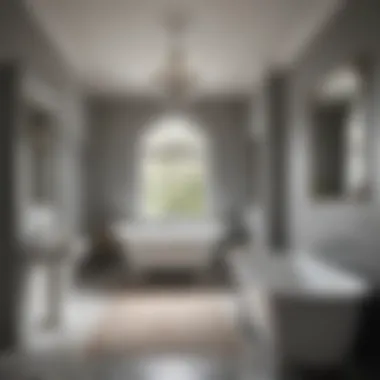
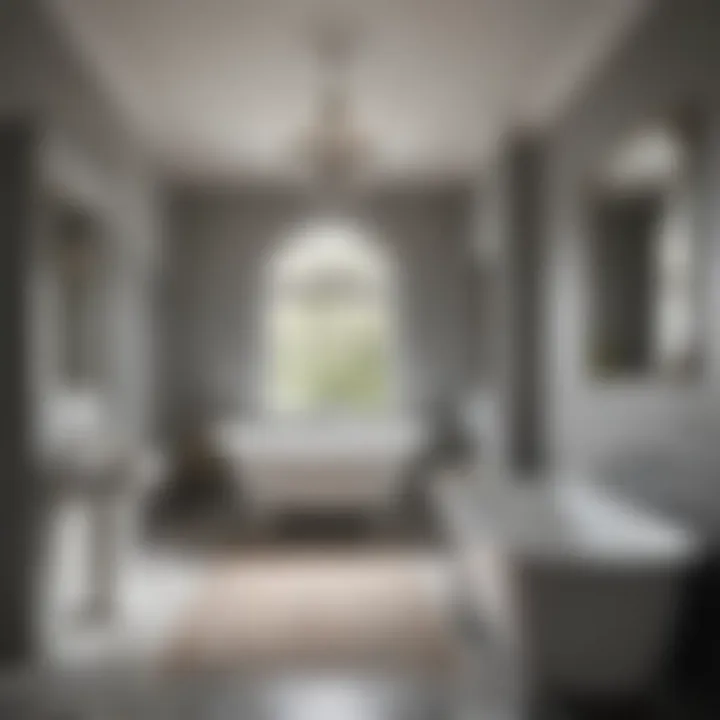
Furnishing Trends: Balancing Comfort and Style
Furnishing trends in British bathrooms highlight the importance of combining functionality with style. Modern bathrooms often incorporate carefully selected fixtures that elevate the design. A balance of comfort and style can be achieved through the selection of vanity units, mirrors, and storage solutions.
Key elements to consider include:
- Vanity Units: These come in various designs, from floating styles that create an illusion of space to traditional pedestal sinks that provide a classic touch.
- Mirrors: Large mirrors not only serve practical purposes but can also enhance the aesthetic. Whether framed or frameless, they should complement the overall design.
- Storage Solutions: Efficient storage options such as shelves or cabinets should harmonize with the room's style while keeping essential items accessible.
"A well-designed bathroom is a joy to use, providing both comfort and elegance."
As these trends continue to evolve, they establish bathrooms not just as practical spaces but as essential components of a home’s interior design.
Cultural Influences on British Bathroom Design
The topic of cultural influences on British bathroom design is essential in this analysis, as it provides insight into how historical, social, and geographical factors shape one of the most private spaces in a home. British bathrooms are not merely functional spaces; they reflect the values and lifestyle of their users. The evolution of bathroom design in Britain has been significantly marked by cultural shifts, which can be evidenced in various styles, materials, and technologies adopted over time.
Influence of British Colonialism on Designs
British colonialism played a profound role in shaping bathroom aesthetics and functionality. During the colonial era, the British Empire expanded its presence across the globe, absorbing influences from various cultures and regions. This period saw the introduction of exotic materials and design elements. For instance, the use of intricate tiles found in Indian palaces inspired the incorporation of decorative features in British bathrooms. The fascination with Asian cultures often led to the incorporation of lavish motifs that were not common in local designs.
These influences manifested in Victorian-era bathrooms—characterized by lavish fixtures that showcased a blend of style and grandeur. People were interested in showcasing their wealth through their bathrooms, which were sometimes fitted with opulent decorations that came from colonial territories.
Furthermore, the colonial legacy also brought about the adoption of sanitation practices that were derived from different cultures. The use of baths in British homes became more common partly due to exposure to lifestyles in warmer climates where bathing was a daily ritual, contrasting the historically colder washing habits prevalent in Britain.
The Role of Sustainability in Modern Bathrooms
In recent years, sustainability has emerged as a prominent theme in the design of modern bathrooms in Britain. This shift reflects a growing awareness of environmental issues and the need for better resource management. Homeowners and designers are incorporating sustainable practices in various ways.
- Eco-Friendly Fixtures: Fixtures such as low-flow toilets and water-saving showerheads are being adopted to reduce water consumption.
- Sustainable Materials: Many designers are opting for materials like reclaimed wood or bamboo, which not only add a unique character but also minimize environmental impact.
- Energy Efficiency: Efficient lighting and heating solutions are becoming standard, with options such as LED lights and underfloor heating gaining popularity due to their lower energy usage.
These practices not only contribute to environmental conservation, but they also resonate with a growing demographic that prioritizes eco-conscious lifestyles.
"Sustainability in design emphasizes the balance between human needs and the health of the planet."
The modern British bathroom, therefore, is not just a personal sanctuary but also a reflection of broader cultural shifts towards sustainability and responsible living. The influences of historical colonial practices blend with contemporary values, marking a significant evolution in how bathrooms are perceived and designed.
In summary, understanding the cultural influences on British bathroom design provides a compelling look at how history and social values intertwine in shaping personal spaces. This narrative not only enhances the comprehension of the past but also serves as a guide to future innovations in bathroom design.
Technological Advancements in Bathroom Features
Modern bathrooms are increasingly defined by technological advancements, which have both streamlined and enhanced the user experience. In recent years, technology has transformed how people use their bathrooms, making them more efficient, safe, and comfortable. Innovations such as smart fixtures and eco-friendly heating systems not only improve functionality but also cater to the growing demand for sustainability. These advancements reflect broader societal shifts towards convenience and environmental awareness. Understanding these features is essential for homeowners, designers, and enthusiasts looking to create spaces that meet contemporary needs while maintaining a sense of style and comfort.
Smart Technology in Bathrooms
Smart technology in bathrooms represents a significant leap towards convenience and efficiency. Features such as electronic faucets, smart showers, and automatic toilets are becoming increasingly popular. Electronic faucets can be activated with a wave of the hand, promoting hygiene while reducing water wastage. Showers can now be programmed to reach specific temperatures or to control water flow, offering users a tailored bathing experience.
In addition, smart mirrors equipped with built-in LED lighting and fog-free technology have gained traction. These mirrors can connect to Wi-Fi, allowing users to check the weather, operate voice assistants, or follow beauty tutorials while preparing for their day.
"The integration of smart technology in bathrooms not only enhances comfort but also encourages sustainable practices through water and energy efficiency."
a. Benefits of Smart Technology:
- Increased convenience through remote access and control.
- Enhanced energy efficiency, leading to lower utility bills.
- Added layers of safety, particularly with features like automatic shut-offs.
b. Considerations:
- Initial costs can be higher than traditional options.
- Compatibility with existing plumbing and electrical systems needs assessment.
Heating Solutions and Their Impact on Design
Heating solutions in bathrooms have evolved significantly, with an emphasis on both comfort and aesthetic appeal. Traditional radiators have largely been replaced or complemented by underfloor heating and heated towel racks. These solutions not only provide warmth but also create a sense of luxury.
Underfloor heating systems offer an even heat distribution, making the bathroom feel warmer instantly. This form of heating is particularly desirable in colder climates, where stepping onto a cold surface can be uncomfortable. Heated towel racks serve a dual purpose, adding warmth to towels while also enhancing the overall design of the space.
Moreover, modern heating systems can be smart-enabled. This allows homeowners to set and control their heating remotely, ensuring a pleasant temperature upon entry.
- Benefits of Modern Heating Solutions:

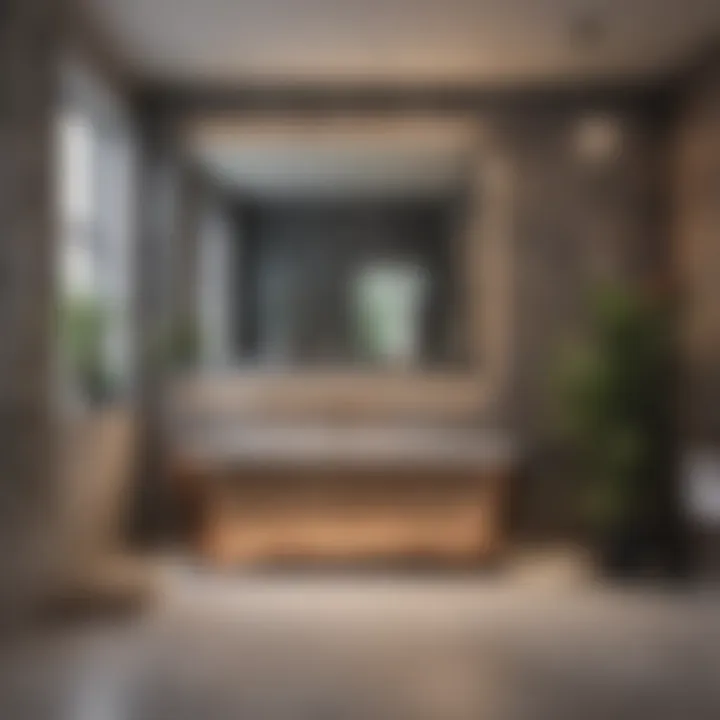
- Increased comfort, particularly during winter months.
- Design flexibility, contributing positively to overall bathroom aesthetics.
- Potential for long-term energy savings through efficient systems.
Size Considerations: The British Bathroom Dilemma
When discussing British bathrooms, size becomes a critical factor. The constraints of space in many British homes directly influence not only the design but also the functionality of these spaces. Recognizing the limitations presents unique challenges and opportunities for homeowners and designers alike.
Common Size Constraints in British Homes
Space issues in British homes are often tied to their architectural history. Many houses from the Victorian and Edwardian eras have small, compartmentalized layouts. This can make it difficult to create spacious bathrooms. Apartments and terraced houses add to the challenge, with narrow rooms and limited access to natural light.
Some notable constraints include:
- Limited Square Footage: Many bathrooms are smaller than the average size found in other countries.
- Structural Features: Solid brick walls, piping considerations, and existing plumbing can restrict layout options.
- Layout Restrictions: Bathroom doors, windows, and positioning of fixtures are often non-negotiable.
Design Strategies for Small Bathrooms
Addressing size limitations does not mean sacrificing style or functionality. Effective design strategies can transform small bathrooms into efficient, appealing spaces. Some approaches include:
- Smart Storage: Utilizing vertical space with shelves and cabinets can maximize storage.
- Light Colors: Opt for light colors to create an illusion of space. Soft whites and pastels enhance brightness and openness.
- Fixtures Scale: Selecting slimline toilets and compact basins can maintain comfort while conserving space.
- Open Layouts: Where possible, creating an open plan that connects the bathroom to adjacent areas can enhance fluidity and space perception.
"The best approach to small bathroom design involves merging aesthetics with practicality, ensuring that even the smallest rooms can serve multiple purposes effectively while remaining stylish."
This section illustrates how size considerations significantly impact British bathroom design and the necessity for innovative strategies in modern homes. This understanding guides homeowners toward creating more functional spaces amid geographical constraints.
Regional Variations in British Bathrooms
Understanding the regional variations in British bathrooms provides insights into the rich tapestry of culture, history, and functionality that characterize these essential spaces. Bathrooms in Britain are not merely practical, but reflect the lifestyle and values of the communities they serve. The differences emerge from several factors such as climate, economic status, and localized traditions, influencing both design choices and function within each region.
Differences in Urban vs. Rural Bathroom Designs
Urban bathrooms in Britain often mirror the fast-paced lifestyle of city dwellers. Space is at a premium, leading to designs that prioritize efficiency and modernity. Compact fixtures, multi-functional spaces, and innovative storage are essential elements in urban environments. Urban bathrooms frequently utilize sleek materials like glass and glossy tiles, promoting a minimalist aesthetic that appeals to young professionals.
In contrast, rural bathroom designs tend to embrace more traditional elements. Often, they feature larger spaces with rustic accents. Stone or wood finishes can create a cozy and inviting atmosphere. The design often pays homage to historical trends and may highlight features like clawfoot baths or farmhouse sinks, offering a nod to the past. Here, practicality meets heritage, reflecting a different lifestyle where space is less of an issue.
Key differences include:
- Space Efficiency: Urban bathrooms necessitate compact designs, while rural bathrooms may prioritize spaciousness.
- Materials Used: Urban designs often reflect modern materials; rural designs utilize traditional elements.
- Aesthetic Choices: Urban bathrooms favor sleek and simple, while rural bathrooms often embrace warmth and character.
Cultural Influences on Regional Bathroom Trends
Cultural factors shape bathroom designs in various British regions. In Scotland, for example, there is a notable emphasis on incorporating natural elements. Scottish bathrooms frequently utilize stone and wood, reflecting a connection to the surrounding landscape. This not only creates an aesthetically pleasing space but also enhances the experience of taking a bath or shower within a natural context.
In contrast, coastal areas, particularly in Cornwall, may incorporate seaside motifs. Light colors and nautical themes are prevalent, mimicking the beach's tranquility. Coastal bathrooms often feature large windows to capture ocean views, maximizing natural light and creating a relaxed environment.
Additionally, multicultural influences are evident in urban settings where designers may integrate diverse cultural motifs. Asian and Middle-Eastern designs might feature intricate tile work or spacious shower areas, reflecting the influence of immigrant communities that shape the local aesthetic.
"Recognizing these cultural nuances can provide a deeper understanding of functionality and aesthetics in British bathrooms."
The importance of these influences cannot be overstated, as they not only reflect the identity of a region but also cater to the needs and preferences of its residents.
Future of British Bathroom Design
The future of British bathroom design is critical as it reflects the evolving demands of modern lifestyles and environmental considerations. Homeowners and designers are looking for spaces that not only function effectively but also resonate with personal style and ecological responsibility. The anticipation of what is to come is shaped by current innovations, sustainability efforts, and shifts in consumer preferences. This section will delve into emerging trends and practices that are set to dominate this vital area of home design.
Emerging Trends and Innovations
The landscape of bathroom design is changing rapidly. One noticeable trend is the integration of smart technology. Features like automatic faucets, smart toilets, and voice-activated lighting not only enhance convenience but also promote efficiency in water usage. Homeowners are looking for ways to make their daily routines more seamless, which technology can provide.
Another innovation is the rise of multi-functional spaces. As homes become more compact, the demand for bathrooms that serve multiple purposes is increasing. For instance, incorporating laundry facilities or workspaces within the bathroom area can optimize space. Furthermore, customization is on the rise, with consumers wanting tailored solutions to fit their specific needs and tastes.
Design aesthetics are evolving too, with a preference for minimalism. Clean lines, neutral palettes, and uncluttered spaces convey simplicity and tranquility. The focus has shifted toward creating serene environments that offer a retreat from the chaos of everyday life.
Sustainability and Eco-Friendly Practices
Sustainability in bathroom design is no longer a trend but a necessity. Consumers are becoming more environmentally conscious and demand products that minimize negative impacts on the planet. Eco-friendly fixtures, like low-flow toilets and water-saving showerheads, are gaining popularity. Not only do they reduce water consumption, but they also lower utility costs, providing financial benefits along with ecological ones.
Another critical aspect is the use of sustainable materials. Bamboo and reclaimed wood are increasingly being chosen for cabinetry and flooring. Moreover, there is an increasing trend toward using recycled materials in construction and finishes. These elements offer durability while presenting a lower environmental footprint.
Using sustainable practices in bathroom design is about more than trends; it is about making a statement regarding how we care for our surroundings.
In addition to materials, energy efficiency is paramount. Considerations around heating solutions, such as underfloor heating systems, can lead to reduced energy consumption and lower heating bills.
The future of British bathrooms indicates a clear shift toward functionality, sustainability, and innovation. By embracing these changes, homeowners and designers alike can contribute to a more responsible yet stylish bathroom experience.



